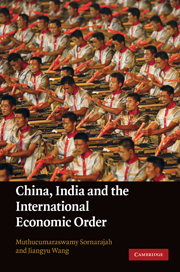Book contents
- Frontmatter
- Contents
- Notes on contributors
- Preface
- Introduction and overview
- PART I China, India and the global trade system
- 1 The WTO and development policy in China and India
- 2 China, India and developing countries in the WTO
- 3 China–India cooperation, South–South coalition and the new international economic order
- 4 India, China and foreign investment
- 5 China, India and WTO Law
- 6 China, India and the WTO dispute settlement system
- 7 China, India and dispute settlement in the WTO and RTAs
- 8 China, India and global outsourcing of services under GATS
- 9 International dispute settlement
- PART II China, India and regional economic integration in Asia
- PART III Law and development in China and India: Domestic issues
- Index
- References
2 - China, India and developing countries in the WTO
Towards a pro-active strategy
from PART I - China, India and the global trade system
Published online by Cambridge University Press: 03 May 2011
- Frontmatter
- Contents
- Notes on contributors
- Preface
- Introduction and overview
- PART I China, India and the global trade system
- 1 The WTO and development policy in China and India
- 2 China, India and developing countries in the WTO
- 3 China–India cooperation, South–South coalition and the new international economic order
- 4 India, China and foreign investment
- 5 China, India and WTO Law
- 6 China, India and the WTO dispute settlement system
- 7 China, India and dispute settlement in the WTO and RTAs
- 8 China, India and global outsourcing of services under GATS
- 9 International dispute settlement
- PART II China, India and regional economic integration in Asia
- PART III Law and development in China and India: Domestic issues
- Index
- References
Summary
Introduction
China and India, two prominent Great Power aspirants (sometimes referred to as ‘a class of two’), declared jointly in 2003, and later re-affirmed repeatedly, their mutual desire in developing wider and closer cooperation in regional and international affairs and, in the context of the World Trade Organization (WTO), in enhancing their cooperation in support of the developing countries.
While not under-estimating their potential for closer cooperation in broad international arenas, the realisation of such collaboration in international affairs will be hampered in the near future at least, as it has been in the last fifty years or so, by the existence of various triangle relationships, such as China–India–USA, China–India–Russia, and China–India–Pakistan, the unresolved issues (e.g. Tibet, national borders and regional ambitions), and the lack of mutual trust between the two countries resulted from its twisted history of bilateral relations. This complex and complicated relationship between the two Asian giants has now produced much discussion and debate on potential threat of growing powers, conflict of ambitions, rivalry for domination, competition for influence, partnership for multipolarity, and cooperation for international peace and security. Much of this literature is produced by scholars in international relations, political science, general Asian studies and economics; and much of the literature on Sino-Indian relations has left more questions than it has provided answers.
- Type
- Chapter
- Information
- China, India and the International Economic Order , pp. 53 - 91Publisher: Cambridge University PressPrint publication year: 2010
References
- 2
- Cited by



